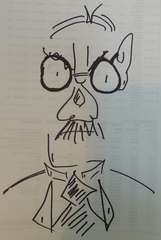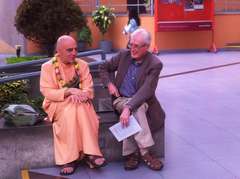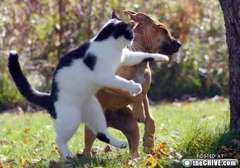HpS - ASA --- Thank you so, so much Srima ART Das! We have read and made little corrections to the English version of this dialog.
It seems to me that we can move ahead to the next object of discussion: Srimad Bhagavatam, https://vedabase.io/es/library/sb/1/9/ Verses 25-29. Maybe Anandamaya Das can give a summary of who is Bhisma deva for Hector??!
-0-0-0-
ART Das - Although the communication by phone was choppy, here is a summary of the dialogue:
At the beginning of the dialogue, Hanumat Presaka Swami gave a brief historical summary of the Gaudiya Vaisnavism and the Acintya-bheda-abheda-tattva philosophy (simultaneous and different identities). Then he explained who Srila Prabhupada was and introduced him as the author of the 'Srimad Bhagavatam’s' Preface, written in India in 1962. That is to say, 3 years before his arrival to America.
At the end of this first intervention, Hanumat Presaka Swami also talked about Bismarck, the Ottoman Empire, Alexander the Great and Arnold Toynbee. (Gurudeva, do you remember the reason? I think it was about the strategy about how to do things).
HpS - It could have been. We certainly want to take advantage of the lessons of history in trying to communicate the message of Krsna and the Bhagavata.
In turn, Héctor started his participation by mentioning that the author uses the human society category at the beginning of the Preface. This is important because the term human society refers not only to people but also to their communication systems, languages, gestures, etc. He mentioned that the human being is the most communicative of all animals in the world and that in order to understand and improve the world, it is correct to speak about human society so that we can be able to understand the reason why a person in the Amazon forest laughs or cries and the reason why another one in London does same.
Then he explained that it is Srila Prabhupada’s success to use the term spiritual brotherhood and to pose the ideal of a common cause. Hector Bejar criticized the Christian and Muslim churches since they assume that their religion is the only true one and that the others are false, so they divide people into 2 groups: The faithful and unfaithful ones: The selected ones -superior beings- and the rest -the inferior beings-.
For him it is correct to talk about spiritual brotherhood, that is to say that this process is for the whole humanity, for the whole spiritual brotherhood without any exception.
The second part of the dialogue was taken up by Héctor Bejar. He mentioned that Srila Prabhupada proposed in this Preface, the re-spiritualization of all humanity, and that in order to do this, we must understand that re-spiritualizing means returning to the spiritual, to include everything that communicates a universal message. Then professor Behar criticized the current society that privileges the material aspects, in a way that for this society, commerce is the most important thing. This is the reason why something is judged to be qualified as good for its possibility to be sold. That material kind of mentality in which the more goods you have the more you are valuable is widely spread in all the media (TV, movies, newspapers, radios, etc.) This mentality generates a society depending on many unnecessary things.
Héctor ended by stating that the spiritual aspect is an inner wealth that we all have.
On his second intervention, Hanumat Presaka Swami mentioned that A.C. Bhaktivendanta Swami was a person who came from a spiritual culture. Then he explained how the universal language is the way to re-spiritualize the whole humanity by sacred dancing and chanting.
The sound was not good during the conversation, so the dialogue ended. Afterwards, I spoke to Héctor Bejar and he manifested agree to discuss about Bhismadeva's instructions next time.
Thank you very much Gurudeva for building bridges to connect to academic people so that through dialogue they can be able to reconnect to the spiritual life..
Hare Krishna GURUDEVA, your insignificant servant, Abhiram Thakur das
-0-0-0-
Dialogo entre SS Hanumatpresaka Swami y el Profesor Hévtor Béjar
Aunque la comunicacion por telefono fue entrecortada, a continuación, un resumen del dialogo.
Iniciando el diálogo el profesor Hanumatpresaka Swami hizo un breve resumen histórico del Gaudiya vaisnavismo y de la filosofía acintya-bheda-abheda-tattva (identidad y diferencia simultáneas) luego explicó quién es Srila Prabhupada, que el prefacio del Srimad Bhagavatam lo escribió en la India el año 1962, 3 años antes de venir a América, al final de esta primera intervención también hablo de Bismark, el imperio otomano, Alejandro el magno y Arnold Toynbee, Gurudeva recuerda el motivo? Creo que era sobre la estrategia de como hacer las cosas
A su turno Héctor comenzó su participación mencionando que el autor al inicio del prefacio emplea la categoría sociedad humana esto es importante porque sociedad humana no sólo se refiere a las personas sino también a los sistemas de comunicación, a los idiomas, a los gestos,… el mencionó que el ser humano es el más comunicativo de todos los animales de este mundo y que para poder entender y mejorar el mundo es correcto hablar de sociedad humana y así entender porque ríe o llora una persona en el Amazonas o porque ríe y llora una persona en Londres. Seguidamente mencionó qué es un acierto (de Srila Prabhupada) emplear el termino hermandad espiritual para luego plantear el ideal de una causa común, Héctor crítico a las iglesias cristianas y a musulmanas ya que asumen que su religión es la única verdadera y que las otras son falsas entonces separan a las personas entre fieles e infieles, entre los elegidos o seres superiores y el resto, los seres inferiores entonces a él le parece correcto hablar de hermandad espiritual, es decir que este proceso es para toda la humanidad, para toda la hermandad espiritual sin excepciones.
La segunda parte del dialogo la retomo Héctor, él menciono que en el prefacio se plantea la reespiritualización de toda la humanidad entonces dijo que para hacer esto debemos entender que reespiritualizar significa retornar a lo espiritual, es decir retomar todo lo que comunica un mensaje universal. Luego critico a la sociedad actual que privilegia lo material por eso para esta sociedad lo principal es el comercio, por eso, se califica que algo es bueno cuando se vende más, esa mentalidad de “más cosas tienes” “más vales” se difunde en todos los medios (Tv, cine, periódicos, radios,…) esto genera una sociedad con muchas necesidades innecesarias. Héctor termino manifestando que lo espiritual es una riqueza interior que todos tenemos.
En su segunda intervención el profesor Hanumatpresaka Swami comenzó mencionando que A.C. Bhaktivendanta Swami está presentando que él es una persona que proviene de una cultura espiritual. Luego menciono que el lenguaje universal para reespiritualizar a toda la humanidad es el canto y la danza espiritual.
Como durante toda la conversación el sonido estuvo entrecortado ahí termino este dialogo, luego hable con Héctor y manifestó su deseo de seguir dialogando esta vez sobre las instrucciones de Bhismadeva.
Muchas gracias Gurudeva por tender puentes con los académicos para que a través del dialogo se reconecten a la vida espiritual.
Hare Krishna GURUDEVA, su insignificante sirviente, Abhiram Thakur das








